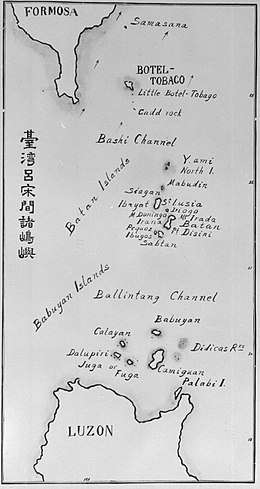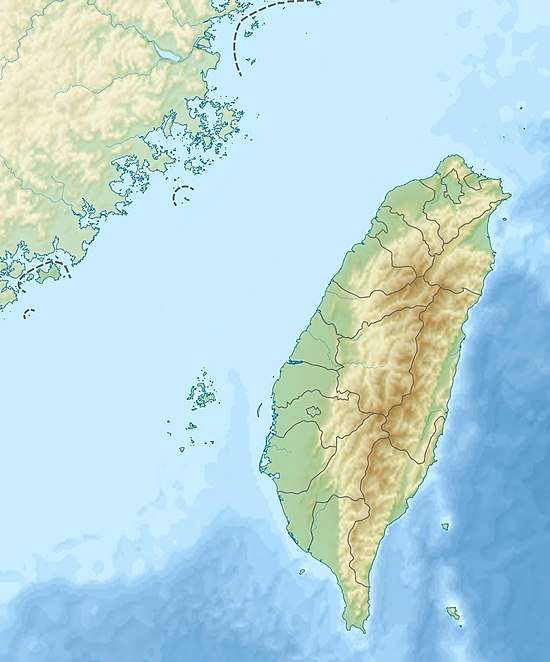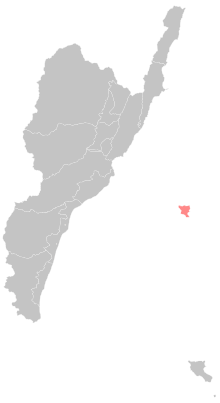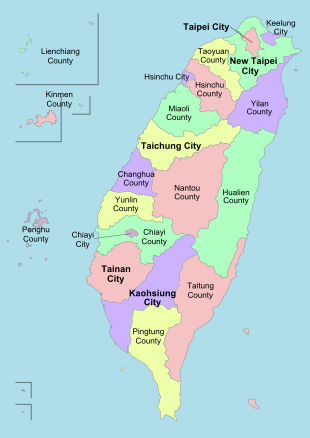Green Island, Taiwan
Green Island, also known by other names, is a small volcanic island in the Pacific Ocean about 33 km (21 mi) off the eastern coast of Taiwan. It is 15.092 km2 (5.83 sq mi) at high tide and 17.329 km2 (6.69 sq mi) at low tide, making it the Republic of China's seventh-largest island. The island is administered as Lüdao Township[1][2], a rural township of Taitung County and one of the county's two offshore areas (the other being Orchid Island). The island once served as a penal colony for political prisoners during Taiwan's period of martial law, although today it is primarily known as a tourist hotspot.
| Native name: Sanasai | |
|---|---|
 Green Island, shown as Samasana | |
 Green I. Green Island in Taiwan | |
| Geography | |
| Location | Philippine Sea |
| Coordinates | 22°40′00″N 121°28′59″E |
| Area | 15.092 km2 (5.827 sq mi) |
| Administration | |
Republic of China | |
| Township | Lüdao |
| County | Taitung |
| Demographics | |
| Ethnic groups | Amis, Han |
| Green Island | |||||||||||||||||||||||||
|---|---|---|---|---|---|---|---|---|---|---|---|---|---|---|---|---|---|---|---|---|---|---|---|---|---|
 Lüdao Township in Taitung County | |||||||||||||||||||||||||
| Chinese name | |||||||||||||||||||||||||
| Traditional Chinese | 綠島 | ||||||||||||||||||||||||
| Simplified Chinese | 绿岛 | ||||||||||||||||||||||||
| Literal meaning | "Green Island" | ||||||||||||||||||||||||
| |||||||||||||||||||||||||
| Japanese name | |||||||||||||||||||||||||
| Hiragana | りょくとう | ||||||||||||||||||||||||
| Kyūjitai | 綠島 | ||||||||||||||||||||||||
| Shinjitai | 緑島 | ||||||||||||||||||||||||
| |||||||||||||||||||||||||
| Bonfire Island | |||||||||||||||||||||||||||
|---|---|---|---|---|---|---|---|---|---|---|---|---|---|---|---|---|---|---|---|---|---|---|---|---|---|---|---|
Lüdao Lighthouse, east of the airport | |||||||||||||||||||||||||||
| Chinese name | |||||||||||||||||||||||||||
| Traditional Chinese | 火燒島 | ||||||||||||||||||||||||||
| Simplified Chinese | 火烧岛 | ||||||||||||||||||||||||||
| Literal meaning | "Fire-Roasted Island" | ||||||||||||||||||||||||||
| |||||||||||||||||||||||||||
| Alternative Chinese name | |||||||||||||||||||||||||||
| Traditional Chinese | 火燒嶼 | ||||||||||||||||||||||||||
| Simplified Chinese | 火烧屿 | ||||||||||||||||||||||||||
| Literal meaning | "Fire-Roasted Islet" | ||||||||||||||||||||||||||
| |||||||||||||||||||||||||||
| Japanese name | |||||||||||||||||||||||||||
| Hiragana | かしょうとう | ||||||||||||||||||||||||||
| Kyūjitai | 火燒島 | ||||||||||||||||||||||||||
| Shinjitai | 火焼島 | ||||||||||||||||||||||||||
| |||||||||||||||||||||||||||
Names
The island was known as Sama-Sana,[3] Samasana and as Samasana Island[4] in the 19th and early 20th century, a transcription of its Amis name Sanasai.
The name "Green Island" is a calque of the island's Chinese name, written 綠島 in traditional characters and 绿岛 in simplified characters. It is also known as Lüdao or Lü Dao from the pinyin romanization of the name's Mandarin pronunciation; as Lu Tao[5] from its Wade-Giles romanization; and as Lek-to from its Hokkien pronunciation. The name was adopted by the Republic of China on August 1, 1949, at the behest of Huang Shih-hung (黃式鴻), the magistrate of Taitung.
Before that, it was usually known as Bonfire Island (or Huoshao), a calque of its original Chinese name Huǒshāo Dǎo (火燒島, 火烧岛).
History
The island was originally inhabited by the aboriginal Amis people.
In March 1864 the British brig Susan Douglas was swept off course and wrecked on the island.[6] Her captain then sailed by junk from the island to Kaohsiung,[6] and the Royal Navy gunboat HMS Bustard found and rescued the remainder of the survivors.[7][8]
In the early 1870s, William Campbell saw the island from aboard the Daphne, and wrote:[9]
We sighted also the Island of Samasana, which is thirty-four miles north of Botel Tobago, and fully fifteen miles east from the Formosan village of Po-song. Consul Swinhoe supposes that it is inhabited by fishermen of Luchuan origin ; but Captain Belcher, of H.M.S. Samarang called there in 1845, and found the population to consist of about a hundred and fifty Chinese from the region of Amoy. They were then gathered into one village, and have greatly increased since that time.
On 11 December 1937 the Dollar Steamship Company luxury ocean liner SS President Hoover ran aground in a typhoon on a reef at Zhongliao Bay.[10] All 503 passengers and 330 crew survived and were safely brought ashore.[10] Over the next few days the cargo liners SS President McKinley and SS President Pierce took the survivors off the island, helped by boats provided by the Japanese cruiser Ashigara and an Imperial Japanese Navy destroyer.[10] Dollar Lines sold President Hoover's wreck to a Japanese salvage company, which spent the next three years breaking her up in situ.[10]
In response to the wreck, members of the US public gave money through the American Red Cross for a lighthouse to be built near Zhongliao village.[6] Lüdao or Lu Tao Lighthouse was designed by Japanese engineers, built by local islanders in 1938[6] and is 33.3 metres (109 ft) high.[11]
A shipwreck of Dutch origin dating to the 19th century was found in June 2013.[12]
Prisons

Green Island first served as an isolated spot and place of exile for political prisoners during the martial law period of Taiwanese history under the Kuomintang, and especially in the White Terror. After their release, many of the prisoners jailed between the late 1940s and the late 1980s went on to establish the Democratic Progressive Party, most notably Shih Ming-teh. Cartoonist Bo Yang served his prison terms there.
The place where most of the political prisoners (such as Shih Ming-teh) were held was "Green Island Lodge" (Lǜ Dǎo Shānzhuāng). "Oasis Village" was the main penal colony. The prison was later closed, and its interior is now open to the public. "Green Island Prison" (Lǜdǎo Jiānyù) is also on the island and has housed prisoners considered to be among Taiwan's most dangerous criminals and gangsters. However, this has changed in recent years.
Geography
The island is formed of volcanic tholeiite, andesite, and volcanic explosive fragments with an area of 15 km2.[13] The volcano erupted from the Pliocene to Pleistocene eras. It is part of the Luzon Volcanic Arc Magma was formed from underthrusting oceanic crust under compression at a depth of about 25 kilometres (16 mi). The andesite rock contains some visible crystals of pyroxene or amphibole. The geochemistry of the rock shows it is enriched in potassium, strontium and rubidium and light rare earth elements. Chromium and nickel are depleted.[14]
Fauna
The island is a habitat for Formosan sika deer, Reeves's muntjacs, Ryukyu flying foxes, and resident and migratory birds.[15]
Local population
In 1995 fewer than half of the registered 2,634 residents of the island actually lived on the island. The population is dwindling due to the difficulty of finding jobs on the island. The island has two pre-schools, one kindergarten, two elementary schools and one middle school. To pursue any education at the senior high school level or above, islanders must move to the main island of Taiwan. Public service centres include one seniors' home, one library, and one community centre.
The villages and the settlements (聚落) they administer are:
- Zhongliao Village (中寮村)
- Zhongliao
- Nanliao Village (南寮村)
- Nanliao (南寮)
- Yugang (漁港)
- Gongguan Village (公館村)
- Gongguan (公館)
- Chaikou (柴口)
- Liumagou (流麻溝)
- Dahu (大湖)
- Zuoping (左坪)
The following abandoned aboriginal tribal settlements also belong to Gongguan Village:
- Youzihu (柚子湖)
- Nanzihu (楠子湖)
- Haishenping (海參坪)
- Dabaisha (大白沙)
Power generation
The island is powered by its only diesel-fired power plant with a capacity of 29.1 MW, consisting of 28 units of generation.[16]
Tourist attractions
- Green Island Human Rights Culture Park
- Lüdao Lighthouse
- Green Island Dive Sites Recreational diving is popular for visitors. There are many dive sites that are established with walkways down to ocean About 150 meter Off Shilang, lies the biggest reef attraction 'Big Mushroom Coral' its height about 12m, width around 31m.
- Zhaori Hot Spring Sea water heated from the volcanic action and raise to surface next to coral reefs at 53℃ and pH7.5.
Transportation
Green Island is accessible by airplane landing in the Lüdao Airport in 15 minutes from Taitung Airport in Taitung City. There are also ferries capable of carrying over 250 passengers reaching Nanliao Harbor (南寮漁港) in around 50 minutes from Fugang Fishery Harbor in Taitung City.[17]
Books
Green island is a subject in the following book:
See also
- List of islands of Taiwan
- List of islands in the East China Sea
- Free Area of the Republic of China
References
Citations
- "About Taitung". Taitung County Government English. Retrieved 14 April 2019.
Lyudao Township{...}Lyudao (Green Island), {...}Lyudao (Green Island)
- "Township (City) Offices". Taitung County Government English. Retrieved 14 April 2019.
Lyudao Township Office
- https://archive.org/details/zoologyofvoyageo00adam/page/n135
- Campbell (1896), map.
- Lu Tao Lighthouse
- "Part Two: The Wreck of the SS President Hoover". SS President Hoover. The Takao Club. Retrieved 7 May 2013.
- "(untitled)". Otago Daily Times. 29 September 1864. p. 4.
- "(untitled)". The Southland Times. 1 October 1864. p. 2.
- William Campbell (1915). "Sketches from Formosa". pp. 46–47.
- Tully, Anthony; Hackett, Bob; Kingsepp, Sander (2012). "Stranding of S.S. PRESIDENT HOOVER - December 1937". Rising Storm – The Imperial Japanese Navy and China 1931–1941. Imperial Japanese Navy Page. Retrieved 7 May 2013.
- "Lyudao Lighthouse". About Taitung. Department of Culture and Tourism, Taitung Government. Retrieved 7 May 2013.
- Hsu, Elizabeth (16 July 2014). "Century-old sunken ship discovered off Green Island". Central News Agency. Retrieved 17 July 2014.
- "Executive Yuan, R.O.C. (Taiwan)". ey.gov.tw. Archived from the original on 2015-10-12.
- Zhang, Jinhai; He, Lishi (2002). "Geology of Taiwan Province". Geology of China. Geological Publishing House. ISBN 7-116-02268-6.
- "Green Island Adventures, Taiwan". greenislandadventures.com.
- "Energy Statistical annual Reports - Energy Statistics - Bureau of Energy, Ministry of Economic Affairs, R.O.C." moeaboe.gov.tw.
- "Taitung Islands Transportation". Tour.taitung.gov.tw. Archived from the original on 2014-04-25. Retrieved 2014-04-30.
Bibliography
- Campbell, William (1896), "The Island of Formosa: Its Past and Future", Scottish Geographical Magazine, 12, pp. 385–399, doi:10.1080/00369229608732903.
External links
| Wikimedia Commons has media related to Green Island, Taitung. |
- Tourism (Chinese)
- Scuba Diving off Green Island (English)
- Book Trips to Green Island here! (English)

